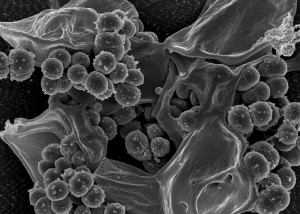I n a recently published article in the New York Times, the Center for Disease Control (CDC) released a study that states 23,000 people die every year from antibiotic-resistant bacteria. They think.
n a recently published article in the New York Times, the Center for Disease Control (CDC) released a study that states 23,000 people die every year from antibiotic-resistant bacteria. They think.
It could be more since they didn’t count the number of people who died of antibiotic-resistant bacteria while those people were already sick with other, non-resistant bacteria.
The article goes on to say that in 2007, over 100,000 people in hospitals died from bacteria that could have been resistant to antibiotics, and that since then, this number has decreased almost 50 percent.
Well, that’s reassuring – even though close to four times more people were dying in hospitals from possibly drug-resistant bacteria than 23,000 people outside of hospitals who were definitely dying of resistant bacteria, now it’s only twice as many people dying in hospitals every year.
The article goes on later to say that the CDC reports infections obtained outside of hospitals have now outreached the number of infections caught inside of hospitals for the first time (50,000 people is not less than 23,000 people, at least the last time I checked).
It’s okay, CDC. I’m not great at math, either.
Aren’t hospitals supposed to make people feel better and not kill them?
Just out of curiosity, how is the number of people who die of drug-resistant bacteria decreasing if the bacteria are resistant to medicine? Medical professionals must be using strategies like hand washing, flu shots, and those annoying little facemasks to keep people safe. I suspect old school witchcraft and nuclear warfare. This must be how they are killing invincible germs.
As if this weren’t ridiculous enough, even the cows aren’t safe.
The article describes the overuse of antibiotics in livestock, since over 70 percent of antibiotics are given to animals. Whether this is to prevent infection in cramped living spaces, or to make the livestock larger, this drug abuse may have some correlation to drug-resistant infections in humans.
The CDC says that using antibiotics on animals and often even on humans, is “unnecessary and inappropriate and makes everyone less safe.”
There is even some connection between those who contract drug-resistant infections and their proximity to farms, although no studies have been conducted to find out whether livestock may actually be carriers of these bacteria.
If you find yourself wondering why this study has never been conducted, it’s because industrial-scale farm companies refuse to allow such testing on their farms.
And that’s sketchy.

Personally, I find this terrifying. Even Dr. Michael Bell, a CDC official, has said, “We are getting closer and closer to the cliff.” I’m not really sure what cliff he’s speaking of, or if it’s metaphorical. I am scared of heights and you should be terrified .
The most alarming and baffling part of this whole issue is that it is unnecessary and wasteful to be using antibiotics in such excess. The animals don’t need it. If an animal intended for sale is sick, it probably should not be considered in the first place. If someone walks into the emergency room with a sinus infection, he or she shouldn’t be prescribed the antibiotics to treat the plague. Maybe it’s the fault of doctors. Maybe it’s the fault of medical schools. Maybe the FDA is to blame. Maybe people are just being overly cautious.
When caution surpasses common sense, we have a societal problem. When 23,000 people are dying every year because we’ve overused our best ammunition, something has to change. When viruses are developing superpowers, we get The Walking Dead. I really don’t want to be a zombie.